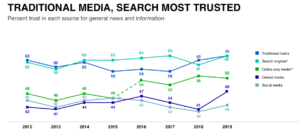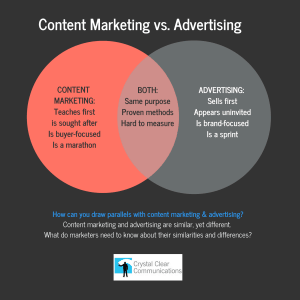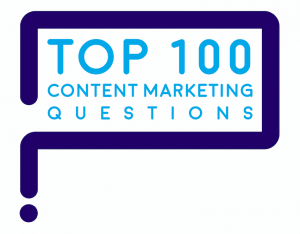Top 100 Content Marketing Question: How to get a traditional TV ad marketing organization to become content marketing converts?

To create content marketing converts:
- Contrast content marketing and advertising.
- Address 3 key questions about buyer needs in your market.
- Share data on eroding ad performance and content marketing growth.
- A/B test advertising and content marketing.
People who don’t understand content marketing may not distinguish it from content. To create content marketing converts, draw the crucial distinction:
Content can be almost anything: a pixel, a line on a piece of paper, a sound.
Content marketing is much more, as the Content Marketing Institute defines it: “A strategic marketing approach focused on creating and distributing valuable, relevant, and consistent content to attract and retain a clearly defined audience — and, ultimately, to drive profitable customer action.”
What’s important and different about content marketing? Its purpose. It attracts and retains a clearly defined audience – converting content consumers into subscribers, subscribers into customers, customers into repeat customers.
Subscribers give you permission to continue marketing to them. Why? Because your content is valuable information that people want.
In contrast, advertising forces a message on people, whether or not they want it.
Contrast advertising and content marketing

To create content marketing converts, stress 6 differences between ads and content marketing.
- Brand-centric vs. customer centric: Advertising is all about the sponsor, the company, the brand, the product or service. In contrast, content marketing is about customer needs. The better you know customers, the easier it is to do.
- Campaigns vs. ongoing commitment: Ad campaigns come and go in a matter of days, weeks or months. In contrast, early examples of content marketing have lasted more than a century. John Deere has published The Furrow since 1897, and Michelin has published the Michelin Guide since 1900.
- Sales message vs. topics and answers: Advertising usually leads with selling. In contrast, content marketing leads with topics of interest to the tribe and answers to buyers’ questions. Ads are about advertisers, and content marketing is for people who belong to a certain audience or tribe.
- Paid vs. paid/earned/owned: Advertising always appears in paid media. In contrast, content marketing appears in all forms of media – paid, earned and owned.
- Interrupting vs. sought after: Since advertising chases consumers, it often interrupts people who are doing something else: watching TV, listening to radio, or reading a web page. In contrast, consumers seek out content marketing because it discusses topics they want to know about, educates and entertains them.
- Self-serving vs. tribe serving: At the end of the day, advertising serves the advertiser. In contrast, content marketing serves a tribe of prospective buyers, by teaching them, building relationships and paving the way softly to a sale.
To go deeper, here’s a blog about how advertising and content marketing are alike … and how they differ.
Address 3 key questions about your market

To create content marketing converts, now it’s time to ask 3 key questions about your market:
- What do customers in your market need most … to learn or to be sold? The higher the risk buyers take on, the more carefully they consider purchases in advance. Content marketing works best on carefully considered purchases – such as houses and retirement plans for consumers or infrastructure and capital facilities for businesses.
- What does a competitive audit reveal? Are competitors in your market investing more in content marketing, or advertising? A competitive content audit will show you what’s happening, either way. If a webpage exists to sell, it’s advertising. If a webpage exists to inform or entertain, it’s content marketing.
- Which web pages show better results … information or selling pages? Check the performance of pages on your website. Do more people use your information pages with content, or selling pages that push the product? If that answer is not clear today, do pilot tests to learn whether information or selling pages get more results over the next 12 months.
Ad viewership is eroding
Given changing consumer habits, how well is advertising working these days?

Consumers are used to paying for streaming videos and music that are uninterrupted by advertising – for example, Netflix, Amazon Prime Video, Spotify and Apple Music. That’s why people are even less tolerant of ads that appear on TV.
An exception is live sports events, which audiences are likelier to watch in real time.
Consider how people treat TV ads:
- 86% of people fast-forward through ads on time-shifted TV shows, says a survey.
- As a result, networks have increased ad content to as many as 15 minutes per hour.
- Yet audiences continue to shrink. Only 28% of people aged 18 to 49 watch traditional TV.
Online, people are skipping ads too.
- 90% of people skip the pre-roll ads on YouTube, says a survey.
- 2 out of 3 people (65%) skip online video ads.
- 2 out of 5 people block website ads on their PCs, while only 1 out of 7 people block ads on their mobile devices.
- Due to banner blindness, website users ignore content that resembles ads, says Nielsen/Norman Group.
Content marketing trust is growing
On the other hand, trust in content marketing that appears in owned media is growing. The 2019 Edelman Trust Barometer shows that:
- 65% of people trust traditional media and content found by search engines.
- 55% of people trust online-only media.
- 49% of people trust owned media such as a company’s website, blog or magazine. It’s worth noting that trust in owned media is up 8% in the past year.
- 43% of people trust social media.

People ignore advertising more and more, yet they seek out information they want to know – which content marketing offers. It’s important to take a professional, data-driven, fact-driven approach to discussions about advertising and content marketing.
That said, facts can backfire. Facts are necessary, but alone they may not be sufficient, to change people’s worldviews.
A true believer in TV advertising may not change his or her mind based the facts you present, no matter how compelling.

Social psychologists Carol Tavris and Elliot Aronson found that when new facts run counter to a person’s worldview, they are rejected out of hand. If someone’s worldview is threatened, they see the facts as their enemy.
It’s easy for people to convince themselves that accurate facts are wrong.
If so, make the case for a pilot project to test content marketing vs. TV advertising over 12 to 24 months. A fair test provides equal resources for each approach.
To create content marketing converts, the ultimate proof will be the results you get, whether they come from TV ads or content marketing.
I’d like to hear how your work to compare ads and content marketing goes – share a comment below.

“How to get a traditional TV ad marketing organization to become content marketing converts?” is one of marketers’ Top 100 Questions about #contentmarketing.
Here are the answers.





